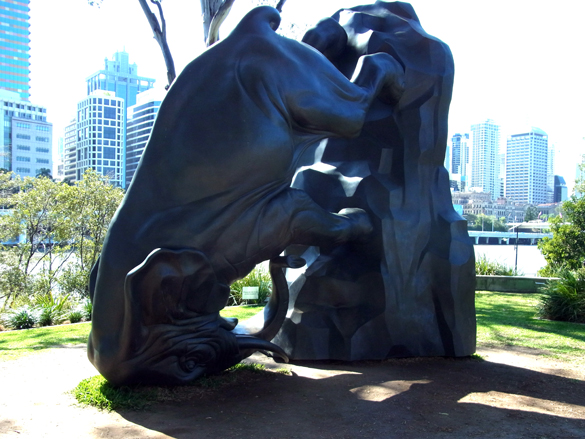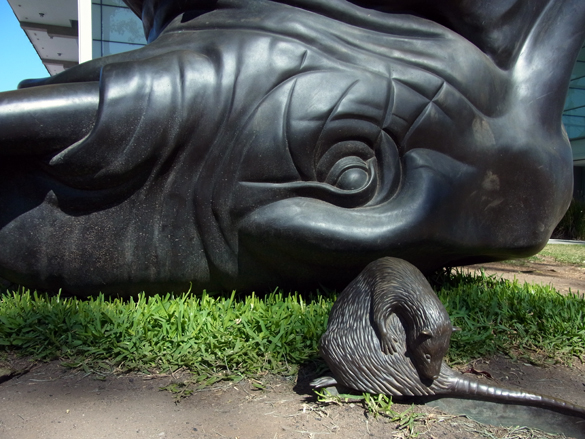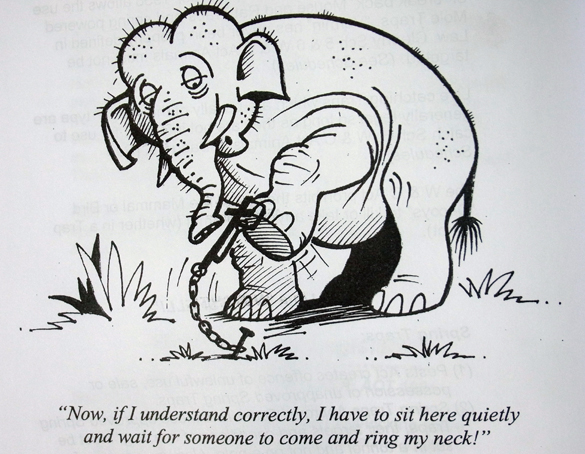Michael Parekowhai‘s bronze is a life-sized Indian Elephant apparently standing on its head with its feet attached to a rock. Beside it, easily overlooked, is a life-sized, Australian, Native Water Rat grooming its bronze fur. The work stands on the South Bank of the Brisbane River outside the Art Gallery. The Elephant is smooth to touch, unlike a real Elephant and I find it a pleasant sensation to run my hands over the wonderful folds in its skin.
Both animals are portrayed in an extremely accurate way, which for me, is the most important thing about any work. I am attracted to realistic sculptures in that I appreciate the skill involved. This may seem strange coming from a cartoonist. (We asked Garth for cartoon examples of these animals and he sent us two he had used to illustrate an article on the law concerning trapping of animals – see below!) The Elephant’s massive strength is somehow accentuated by the way it is pushing back on the rock to prevent itself being turned on its back. The Rat’s fussy grooming is typically rodentious – now there’s a new word for the dictionary! So I find myself liking this unusual work very much. I walk around it and realise that its placement with the background of the impressive Brisbane skyline adds greatly to my enjoyment.
Then I read about the sculpture. “The World Turns” was commissioned by the Queensland Government in 2011. The descriptive plaque tells us that the Native Rat is a hero, a traditional caretaker, together with the Native People, of the Mangroves at Kurilpa point where the Gallery stands. This initially seems to give some geographical meaning to the work. It continues by telling us that the Rat goes about his business even though he has shifted the World, as represented by the Elephant and rock, from its axis. Oh! Dear! I am becoming confused! Not hard to do, I know, but I don’t like it. I read on about how the work “reminds us that history is often recorded to highlight specific moments, but, as the world turns, there are many other stories – and these are central to our understanding of history”. Now I am truly confused! Obscure and multiple meanings, poorly written, do not serve this wonderful work well in my opinion.
I walk away, annoyed that what I consider to be pretentious “art speak” has spoilt my complete enjoyment of the sculpture. This situation forces me to think about which is ultimately the more important, the work or the idea that drove its creation. I know that the two cannot exist without each other and the question is a difficult one. I try to find an analogy or parallel to clarify my thinking. I find it in poetry, where I am sure that any idea is given more power by words that intelligently and beautifully rhyme rather than simply being written down? Therefore the work is the greater of the two, ultimately speaking to us of its own beauty in spite of the idea that spawned it.





Hello. Parekowhai had the pleasure of teaching me in my second year. Alas he will remember. Furthermore, I will remember. Pleased with whatever I am writing, I can only add that he is one talented bullshit artist with whom I greatly admire. Now “bullshit”, in this context, advocates no such disrespect that one may believe. I am a fan. I am the fan.